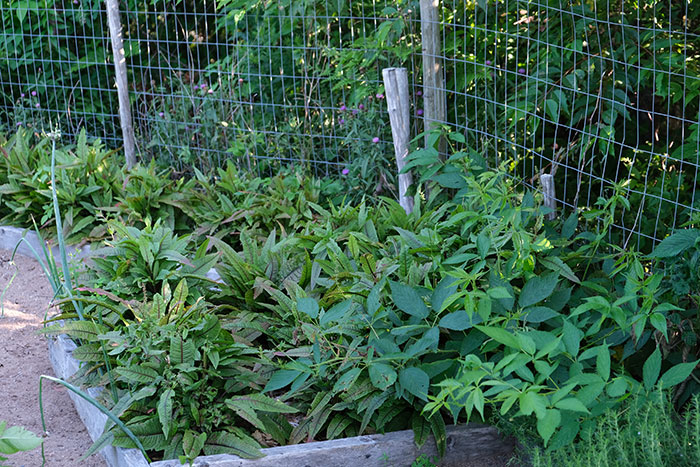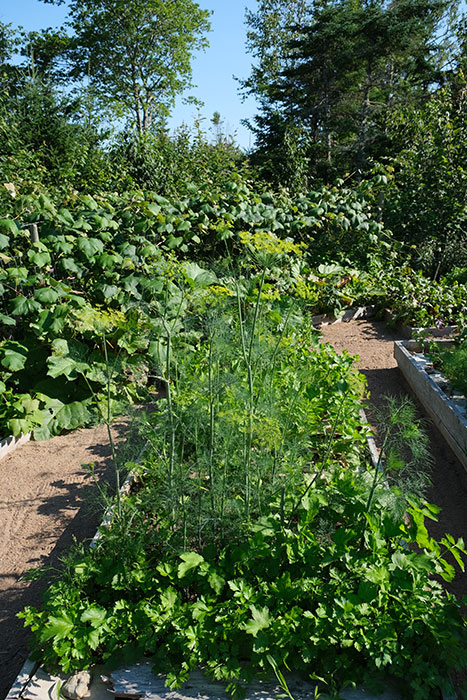Garden of Greg Auton
Greg Auton, Brookside, Nova Scotia
Story and photos by Shauna Dobbie
As Greg Auton shows people his garden, he doles out his matter-of-fact information with the understated excitement and pride of a horticulturist. He’s not a horticulturist, though; he doesn’t spend more than an hour per week in the garden, except at planting or harvesting, and he has a full-time job in the city, with an hour commute each way. But he grows a huge portion of his family’s produce in an area carved out of Nova Scotia brush, protected by 6-foot page-wire fences. And besides that, he does podcasts and videos about gardening. How does one person manage all that?
The 50-by-50-foot space is very tidy, with sand about 5 inches deep between (mostly) rectangular beds. He confesses that he did weed the sand walkways before we came to make it more photogenic, but by and large, the sand keeps the weeds at bay without much help. The beds are defined by logs, boards or stones. Some are less rectangular, hugging the curves of the border.
Outside of the fenced-in garden, he may try something in the wild areas. One year he mowed the weeds, put some seed potatoes down and covered it all with straw in the spring; in fall, he harvested a respectable number of potatoes. Last year he grew a couple of pumpkins just outside the bed. On the way to the fenced area, he has four hugelkultur beds where he plants vegetables that aren’t bothered by deer and rabbits, which are common visitors. (Hugelkultur beds are built by laying down logs, topping them with smaller and smaller pieces of wood and grass and eventually compost.)
How does he spend so little time in the garden? For one thing, he mulches heavily. This works in Nova Scotia, where he can expect annual precipitation of 1,467 millimeters; Winnipeg, by comparison, gets only 514 millimeters per year. That much rain and snow means he doesn’t have to water very often. And in addition to keeping in moisture, mulching means fewer weeds grow and they’re easier to pull if he wants them gone. Once the plants get big enough, they shade the weeds to keep them down.
About half of what Greg grows is root vegetables, all of which store well. Potatoes he can leave in the ground until his garage is cool enough to store them. Carrots and parsnips can stay in the ground until just before it is frozen; in fact, they get sweeter with the cold. He grows these and Jerusalem artichokes, beets, and lots and lots of garlic.
Garlic is a plant that gives to the grower twice; everybody knows you can harvest the bulbs in late summer, but Greg also harvests the scapes. Garlic sends up a stem, and when the long flower bud at the end curls around into a complete circle, you can cut them back. The scapes are a milder version of garlic cloves and Greg puts them in lots of his cooking. He also makes pesto out of them that he can freeze for use all year round. The bulbs of garlic that he harvests later, of course, keep indefinitely.
He also grows a lot of kale and other greens. Kale is ideal because it can be chopped and frozen and it doesn’t turn to mush when you use it later. Greg also devotes parts of the garden to lettuce, which his wife Joy loves, and sorrel, which has the advantage of being perennial. He usually grows collard greens, but this year he gave cabbage a try instead. Some insect got into the cabbage, though, making it a pain to clean, and next year he’s going back to collards.
Beans, peas, broccoli, squash and tomatoes round out the mini farm nicely, and he has an apple tree and a full bed of strawberries for freezer jam. His raspberries are coming along after a couple of years and he expects to have enough to make some jam next season. He has blueberries growing, too.
And oh, I forgot to mention the zucchini and onions. And asparagus. Dill, lovage and parsley. (Other herbs grow next to the house.) And there is one small bed where he grows irises and tulips, for Joy.
One stunning thing about Greg’s approach to gardening is that he plants everything from seeds, and he does it all directly into the garden. To those of us who fussed with grow lights and leggy tomatoes last year, this sounds like sacrilege, or maybe like we’ve been lied to. But he does put the effort in to warming up the beds early and getting things going under hoop houses. He builds them out of 1-by-3, remesh (a bendable sheet of wire laid in a grid), and poly sheeting. It is remarkably easy if you follow his video.
He spends very little money on his garden. Part of the savings is owning to sponsorships from Veseys Seeds and Safer’s products for Maritime Gardening, but he doesn’t put money into buying compost or topsoil. He mulches with yard waste, which he picks up from the ends of people’s driveways. It’s not an agreement; he pilfers bags put out for municipal pickup. Does the yard waste contain weeds? Absolutely. But he piles it on thick enough that it doesn’t matter too much. The weeds that do grow, he will just pull and leave on top of the bed as new mulch.
Greg is an inspiration to gardeners everywhere, especially those who are lazy or time strapped. His message is simple: do what needs to be done, don’t bother with what doesn’t need it, and in the end you will eat well.
October in the garden:



































